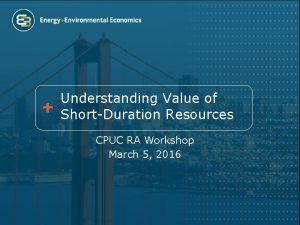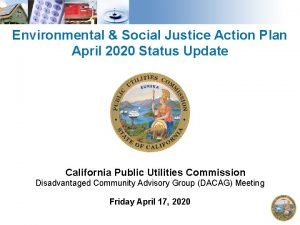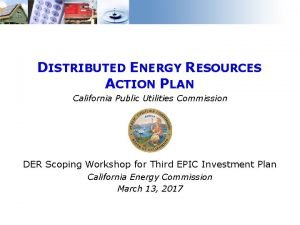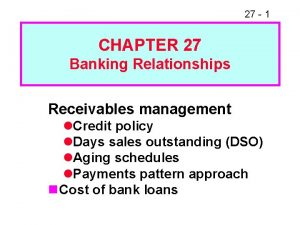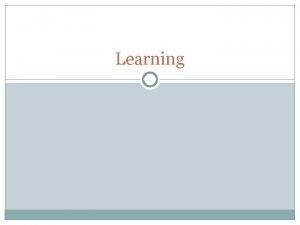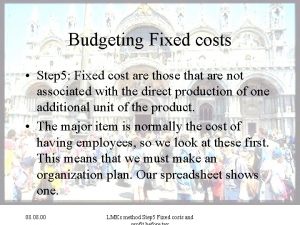CPUC Fixed Cost Workshop Real Economic Carrying Charge







- Slides: 7

CPUC Fixed Cost Workshop: Real Economic Carrying Charge (RECC) Method November 2, 2016 Reuben Behlihomji - SCE Southern California Edison

Recap & Today’s Agenda q Authorized Revenue Requirements: Total amount of cost recovery authorized by the Commission for different functional components of utility revenue • Energy Charges o Fuel and Purchase Power o GHG o DWR Power charges • Balancing Accounts • Public Purpose Programs The difference in cost for a finite increment of product or service provided. These costs are typically categorized into short run and long run costs. Marginal costs reflect the principles of cost causation when allocating revenue responsibility to rate groups. • Generation o Energy – Short run value of energy (k. Wh) market prices for a fixed level of installed generation capacity o Capacity – Long run value of investing in new generation capacity (k. W) • Base Charges o Utility owned generation o Distribution o Transmission q Marginal Costs: Today’s Agenda: RECC Method • Delivery - Distribution o Customer Long run value of customer connection costs (Transformer, Service Drop and Meter) Short run value for customer service costs o Design Demand – Long run valuation of investments in capacity (k. W) addition • Delivery – Transmission o Marginal costs have not been adopted at FERC CONFIDENTIAL 2 Southern California Edison

What is RECC? • Real Economic Carrying Charge (RECC), or “rental”, method as used in revenue allocation and rate design captures the full economic value of deferring a capital investment • It offers a long-run view of marginal costs where the deployment of capital, as a factor of production, changes over time • Uses of RECC include: ‒ Generation Capacity ‒ Distribution Design Demand – Load Growth ‒ Distribution capital for customer connection costs 3 Southern California Edison

RECC Example – Distribution Line Transformer • The full economic value of deferring invested capital in the distribution line transformer for one year is 10% (RECC = $10) of the initial capital investment of $100. • Both RECC and New Customer Only (NCO) methods produce the same revenue requirement when RECC is calculated over a single life cycle (Cycle 1). • Both RECC and NCO methods account for second lifecycle replacement. PV of RR in Year 0 = $199 Perpetuity Stream RECC = $10 ($199 minus $189) PV of RR in Year 1 = $189 Perpetuity Stream PV of RR in Year 0 = $167 Single Life Stream Yr. 0 Yr. 1 Cycle 1 Revenue Requirement (RR) Cycle 2 Initial Investment = $100 Year 33 Key Assumptions: WACC = 7. 9%; Inflation = 2. 14%; Average Service Life = 33 years 4 Southern California Edison

NCO vs. RECC Marginal Connection Cost The marginal cost of adding the same incremental customer changes under the NCO method when the base number of existing customers varies • [Cost x PV x Growth Factor (GF); where GF = New Customers Existing Customers] Applying the NCO method is challenging in situations when a rate group may experience stagnant customer growth or in some cases with a declining base of customers • NCO: of Existing Customers =1 Starting base of. Base existing customers =1 NCO: of Existing Customers Starting Base of. Base Existing Customers =5 =5 NCO: of Existing Customers Starting Base of. Base Existing Customers = 10 NCO: of Existing Customers Starting Base of. Base Existing Customerst = 100 NCO: of Existing Customers Starting Base of. Base Existing Customers = 1, 000 Starting Base of. Base Existing Customers = 5, 000 NCO: of Existing Customers RECC -All All. Customer. Count RECC: 180 160 $157. 4 Normalized MC Value 140 $127. 4 120 $102. 9 100 80 $83. 6 60 $23. 1 40 $27. 9 $10. 6 20 0 $2. 63 $0. 53 1 2 3 4 5 6 7 8 9 10 11 12 13 14 15 16 Number of New Customers Added *Refer to speaker notes for a more detailed description of the above graph. 5 Southern California Edison

Normalized Marginal Cost Trend of Adding a New Customer The NCO marginal cost trend is symbolic of observed average cost curves when amortizing a fixed base of capacity investment over varying additions or reductions in customer count. 16 Hypothetical construct when one customer added each year with a starting base of one customer 14 Normalized Cost Value 12 10 NCO Marginal cost of adding one customer under NCO changes based on when the customer is added 8 6 RECC Marginal cost of adding one customer under RECC is constant 4 2 0 1 2 3 4 5 6 7 8 9 10 11 12 13 14 15 16 17 18 19 20 21 22 23 24 25 26 27 28 29 30 31 32 33 34 35 Years *Refer to speaker notes for a more detailed description of the above graph. 6 Southern California Edison

Key Takeaways RECC NCO How T&D Capital Investment Will Be Recovered Over Time Long-Run Short-Run Marginal Cost of Connecting an Incremental Customer Constant Varies Revenue Requirement Challenge(s) 7 (Despite the starting base of existing customers) (inversely w/ the starting base of existing customers) Annuity Present Value Theoretical construct that attempts to replicate a utility’s economic cost of service Undefined in the case of stagnant or negative customer growth Southern California Edison

